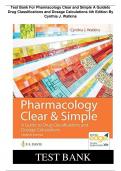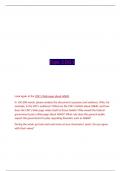Exam (elaborations)
Test Bank For Pharmacology Clear and Simple A Guide to Drug Classifications and Dosage Calculations 4th Edition Watkins
- Course
- Institution
- Book
Test Bank For Pharmacology Clear and Simple A Guide to Drug Classifications and Dosage Calculations 4th Edition Watkins
[Show more]




